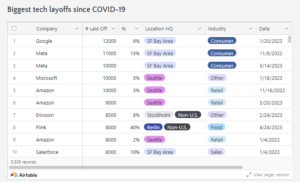Job Market Trend Data End of Q4 2023
The US labor market ended strong in 2023 with 216,000 new jobs in December and the unemployment rate remaining steady at 3.7%. Despite predictions that interest rate hikes would decelerate the economy and increase unemployment, the labor market outperformed expectations. Wages increased by 4.1% for the year ending in December, up from 4% in November. The healthy job environment contributed to sustained consumer spending which was a key contributor to the resilient economy. This resulted in a robust demand for workers and caused the Gross Domestic Product (GDP) to grow at an annualized rate of 4.9% in 2023’s third quarter, the quickest pace in over two years.
By examining industry-specific trends within Q4 2023, we can identify growth areas that offer promising career prospects for individuals seeking employment or considering a career change. Additionally, understanding declining industries can help individuals navigate potential challenges and plan accordingly. This report aims to provide an insightful overview of job trends in Q4 2023 while considering their broader implications on the United States’ economic landscape.
Overall Employment Growth And Unemployment Rate In Q4 2023
– The unemployment rate remained at 3.7 percent with 6.3 million unemployed persons in December. These rates are slightly higher than the previous year’s rates of 3.5 percent unemployment and 5.7 million unemployed persons.
– Different demographic groups showed minimal change in their unemployment rates: adult men (3.5 percent), adult women (3.3 percent), teenagers (11.9 percent), Whites (3.5 percent), Blacks (5.2 percent), Asians (3.1 percent), and Hispanics (5.0 percent).
– The number of long-term unemployed persons (jobless for 27 weeks or more) stayed constant at 1.2 million, accounting for 19.7 percent of all unemployed people in December.
– The labour force participation rate dropped by 0.3 percent to 62.5 percent, and the employment-population ratio also decreased by 0.3 percent to 60.1 percent.
– The number of people employed part-time for economic reasons remained at 4.2 million but increased by 333,000 over the year. These people prefer full-time jobs but work part-time as they can’t find full-time employment or have had their hours shortened.
– The number of people not in the labour force but who want a job rose to 5.7 million. This group doesn’t count as unemployed because they haven’t actively been searching for work or were unavailable for work.
– Among those not in the labour force who wanted a job, the number of marginally attached individuals remained at 1.6 million. This number includes discouraged workers who believe no jobs are available for them; their count, at 346,000, showed no significant change.In the fourth quarter of 2023, the United States is poised to experience a steady and robust employment growth, reflecting a positive outlook for the nation’s job market.
Manufacturing, technology, healthcare, and professional services are anticipated to be among the key drivers of job creation during this period.
With increased consumer spending and business investments, these industries are likely to expand their workforce significantly. Furthermore, as companies continue to embrace digital transformation and automation technologies, there will be an increased demand for skilled workers in emerging fields such as artificial intelligence (AI), data analysis, cybersecurity, and renewable energy.
Was 2023 the Year of the Layoffs ?
In 2023, a series of mass layoffs affecting over 305,000 U.S. employees led to diminished employee satisfaction and amplified pressure on middle management. Necessitated by economic uncertainties, these layoffs, beginning from tech firms to various sectors, substantially eroded job satisfaction as revealed in Glassdoor’s 2024 Workplace Trends report. The report, based on reviews from staffers of over 100 different companies impacted by the layoffs, noted a significant strain on middle and lower managers, hence forecasting sustained hardships into 2024. Chief Economist Aaron Terrazas envisages stepped-up effort by companies to boost staff morale in the subsequent year, while the brunt of employee displeasure is likely to be borne by middle managers.
As the United States economy continues to evolve, Q4 2023 presents several emerging industries that are poised to create exciting job opportunities. These sectors are driven by technological advancements, evolving consumer demands, and global trends. One such industry that is expected to experience rapid growth is renewable energy. With increasing concerns about climate change and the push for sustainable solutions, the demand for clean energy sources like solar and wind power is skyrocketing.


Impacts Of Technological Advancements Like A.I. On The Job Market
1. Changing Job Roles: AI can automate repetitive tasks, freeing up more time for human employees to focus on creative and complex responsibilities. This change may lead to a shift in job roles, with more emphasis on technical and problem-solving skills.
2. Job Displacement: The increased efficiency from AI automation can result in certain jobs becoming obsolete, causing job displacement. While some industries may decline, new industries and careers are likely to emerge centered around AI and technology.
3. Unemployment: In the short term, rapid AI advancements may lead to increased unemployment rates, especially among those with lower qualifications or in industries heavily relying on manual labor.
4. Skill Gap: The adoption of AI can result in a skills gap. Workers will need to learn new skills to keep up with the changing job market. However, not everyone might have access to such training, leading to inequality in the workforce.
Technological advancements have had a profound impact on the job market, shaping the landscape of employment opportunities in various industries. As we look ahead to Q4 2023 in the United States, it is crucial to understand how these advancements will continue to influence the job trends. Automation, artificial intelligence (AI), and robotics are revolutionizing industries across the board. While these innovations have undoubtedly increased efficiency and productivity, they have also led to concerns about job displacement.
Many routine tasks that were once performed by humans are now being automated, resulting in a shift in job requirements and skill sets. Certain occupations are at a higher risk of being replaced by automation than others. For instance, jobs that involve repetitive manual labor or data processing may become obsolete as machines become more capable. On the other hand, technological advancements create new opportunities for skilled professionals who can adapt and leverage these tools effectively.
Job Market Trends in 2024
As we look beyond Q4 2023, it becomes imperative to analyze the long-term implications and potential shifts in job trends in the United States. Several key factors are likely to shape the employment landscape, influencing the types of jobs that will be in demand and those that may become obsolete. 1. Technological Advancements: The rapid pace of technological advancements is expected to continue reshaping industries across sectors.
Jobs requiring specialized digital skills, such as data scientists, AI engineers, cybersecurity experts, and virtual reality developers, are predicted to witness significant growth. Additionally, automation and artificial intelligence may impact traditional roles like administrative assistants and manual laborers. 2. Green Economy: With an increased focus on sustainability and combating climate change, it is expected that job opportunities in renewable energy sectors will expand.

charts sourced from layoffs.fyi




